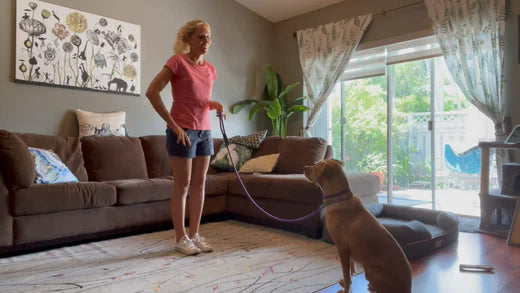MASTER STAY COMMAND FOR DOGS: BENEFITS & STEP-BY-STEP GUIDE

Breaking down E-collar conditioning 1 fundamental concept at a time! The 3 most important things for your dog to understand before utilizing a remote training collar are:
- Come to me
- Go away from me
- Go stationary
In the 2 previous blog posts, we discussed the concepts: come to me and go away from me. Now, let’s round out the trifecta with the concept of going stationary.
Benefits of Teaching Your Dog Stay Command
Teaching your dog to go to their designated place can be a lifesaver in tight spaces such as the kitchen or living room. With the place command, you can move around your dog with ease and prevent accidents when handling hot pans or opening the oven.
Door Manners
Does your dog rush out the door every time it's opened? Teaching your pup to go to their place when someone comes to the door can prevent them from bolting out into the street or jumping on guests.
Off-Leash Control
The place command can also be helpful when you're out and about with your pup off-leash. By teaching your dog to go to their place, you can keep them out of harm's way and prevent them from approaching other dogs or strangers.
Mental Stimulation
The place command also provides mental stimulation for your furry friend. By giving them a specific spot to go to, you're providing structure and routine in their daily life, which can help reduce anxiety and boredom.
By teaching your dog the place command, you can provide them with a sense of safety and structure while also making your life easier and more enjoyable.
How to Teach Stay Command to a Dog
We will demonstrate this concept by using the Stay command. Before starting to train, grab some treats and put your dog on a leash. Start this training without the use of the e-collar. We must first establish the new behavior long before we ask our dog to perform it when the static stimulation is applied from the E-collar.
Teaching your dog to "stay" is an important command that can keep your pet safe and under control in various situations. Whether you want your dog to stay put while you open the door or wait for your signal before crossing the street, a well-trained "stay" behavior can come in handy. Here are the steps to teach your dog the "stay" command:
Step 1: Begin with the "Sit" command
Start with your dog on a leash and give the "Sit" command. If your dog doesn't know how to sit yet, take some time to condition this behavior before proceeding. When your dog sits, give them a treat and say "stay."
Step 2: Add duration and distance
Stand straight up and wait one second before giving your dog another treat as a reward for following the command. If your dog gets up from the "Sit" position, use light leash pressure upwards and command "Sit" to put them back in place. Once your dog can hold the "Sit" position, take one step back while holding the leash, and wait a few seconds before returning to your dog to give them a treat.
Step 3: Practice with distractions
Continue taking steps away from your dog while holding the leash, gradually increasing the distance and duration of the "stay" behavior. As you move further away, use the leash as a steering wheel to guide your dog back into the "Sit" position if they break the command early. You can also step side to side to begin proofing the "Stay" command.
Step 4: Test their skills with distractions
Once your dog has mastered the "stay" behavior in a distraction-free environment, it's time to test their skills in a more advanced setting. You can add distractions, such as toys or food, and see if your dog can maintain the "stay" command. Remember to reward your dog for good behavior and be patient as you continue to train and refine their skills.
How to Train Your Dog Stay Command Using an E-Collar
When your dog is able to hold the position, you are then ready to layer over the e-collar static stimulation. Layering over your e-collar to the Stay command is done just like we did with the Come and Place command. At this point, if you have not found your dog’s working level, revisit the last blog to do so before layering the e-collar over the place. Put your e-collar and leash on your dog and go back to asking for Sit and Stay. If your dog breaks the sit behavior, apply light static stimulation using the Nick or Continuous button on your handheld transmitter. Use your leash, body, treats, or words to guide/assist your dog back into the position if needed. Once your dog sits again, you can release stimulation and give them a treat. Do not increase distance, duration, or distraction until your dog demonstrates that they can understand the stay command when the static stimulation is applied.
Final Thoughts
Stay is not only used to keep your dog in a sit, it can also be used to keep them in a stand, down, place, and many more behaviors! Getting a reliable stay is so crucial to the safety of your dog both on and off the leash. It also will give you time to assess a situation and guide your dog to the best decision.
This completes our series on the three concepts to train your dog before using a remote training collar! Through mastering all 3 things, you will enhance your training journey and truly be working towards having a top-notch dog.




